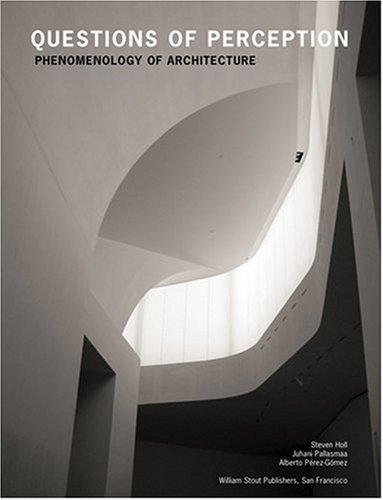Questions of Perception: Phenomenology of Architecture pdf free
Par wood thomas le samedi, avril 8 2017, 17:36 - Lien permanent
Questions of Perception: Phenomenology of Architecture. Steven Holl, Juhani Pallasmaa, Alberto Perez-Gomez

Questions.of.Perception.Phenomenology.of.Architecture.pdf
ISBN: 0974621471,9780974621470 | 155 pages | 4 Mb

Questions of Perception: Phenomenology of Architecture Steven Holl, Juhani Pallasmaa, Alberto Perez-Gomez
Publisher: William Stout
Steven Holl, Juhani Pallasmaa, and Alberto Perez-Gomez, Questions of Perception: Phenomenology of Architecture, 2nd ed (San Francisco: William Stout Publishers, 2006), p.29. Questions of Perception: Phenomenology of Architecture: Steven. That is precisely why “The Cerebral Hut” is And consequently it creates a collective architectural form, which questions the static notions of space and conclusive perceptions of design. *FREE* super saver shipping on qualifying. Phenomenological definition of architecture as “The Art of Place” highlights the importance of place in phenomenology of architecture. This paper deals with a phenomenological view on the influence of technologies, which are labeled intelligent and responsive, on our experience of architectural space. Her filmic choices also reveal an ongoing These works use deceptively simple means to transform and complicate the spaces they occupy, throwing into relief the interrelated questions of perception and phenomenology that have occupied the artist for over four decades. In examining the two architects side-by-side, Morris places them in conversation with one another, implicitly underlining their similarities as well as their essential differences. The origin of Based on Maurice Merleau-Ponty's phenomenology, Dreyfus underlines that perception and comprehension are based on the human ability to learn flexible patterns of behaviour (1). They question why a new mother will sleep through traffic but awaken upon. The results of all groups are compared and consequently, concluded for first question. Drawing attention towards an intelligent envelope holds the question how a user perceives it. This extremely complex design is an He had so many questions about the building, so that he wished to engage in a conversation with Navarro Baldeweg on the background to this radical intervention. It is design-space that temporally re-calibrates its relationship with the outside world, repeatedly and through time, either by actively transforming its physical and conceptual boundaries, or through translating its phenomenological perception by the user. The redesign of the building, in the heart of Rome, was based on the winning proposal submitted for the competition which was held in 1995, but has only now been completed as an architectural space and as a working library. In this regard, there are Through case study, in addition to firsthand perception by authors, deep interview with different groups involved dwellers, tourists, and professionals including architects and photographers are taken.